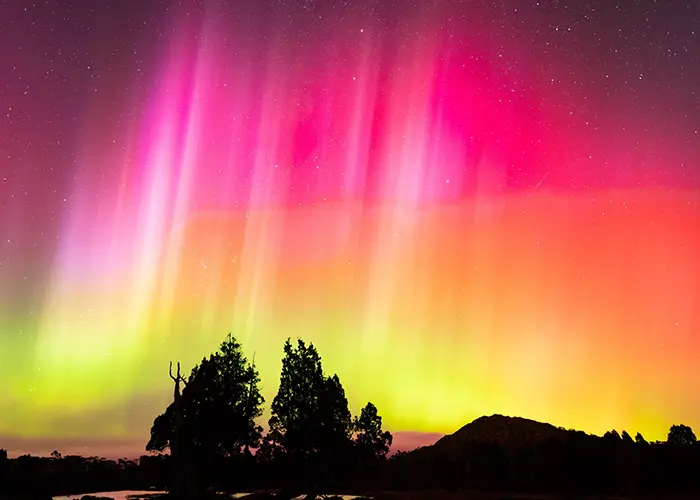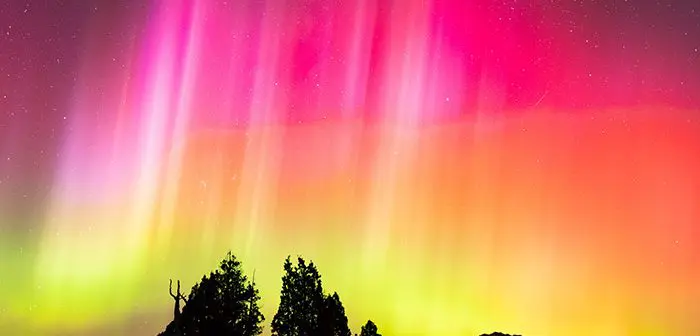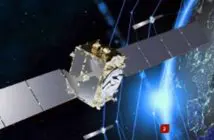
CSIRO experts say the recent spate of solar flares has the potential to damage satellites and knock down power grids. Last weekend’s aurora was so strong it was seen in cities and towns across Australia’s southeast.
“It’s impossible to say exactly when the solar maximum will peak, but we are tracking several sunspot clusters, including those responsible for the recent auroras,” said CSIRO Space and Astronomy Science Director Dr Mark Cheung. “Space weather forecasters constantly monitor the Sun, solar wind, and space environment, and offer forecasts of varying certainty from around 24 hours to 30 minutes in advance.”
Solar activity is closely linked with the number of sunspots, or bundles of magnetically charged plasma, which can collide, shear, and snap, sending strong radiation out in all directions. In extreme cases, entire bundles of charged particles—called coronal mass ejections, or CMEs—can be shot out in one direction. If these bundles are aligned with Earth’s magnetic field, they can cause additional damage.
Sunspot numbers wax and wane over an 11-year solar cycle. The US National Oceanic and Atmospheric Administration (NOAA) has forecast that the solar maximum will peak in 2024, making flares and coronal mass ejections more likely.
“Solar storms can manifest as solar flares, which are enhancements in ultraviolet and x-ray radiation,” said Cheung. “Once emitted, the radiation takes about eight minutes to reach the Earth. The energetic radiation can ionise atoms in the Earth’s upper atmosphere and cause it to puff up. This can cause radio communications blackouts, errors in global positioning systems, and increase drag on satellites, changing their orbits.”
“The Earth’s own magnetic field acts like a shield, partially protecting us from the impacts of CMEs and the ambient solar wind. But when a strong CME hits, the Earth’s magnetic field rings like a bell, manifested as geomagnetic storms. This can cause anomalous currents over long-distance electrical cables and pipelines, posing threats to critical infrastructure such as power grids. On the plus side, geomagnetic storms are often accompanied by beautiful aurora in the north (Aurora borealis) and in the south (Aurora Australis). Sometimes, as on May 11 and 12, the aurora can even be witnessed from mainland Australia.”
“Some flares and CMEs are also accompanied by particles accelerated to near the speed of light. These travel along the superhighways that are magnetic fields connecting the Sun and Earth. Deposition of these particles on satellites can degrade their components, including solar panels and sensitive instruments.”
Dr John Morgan, a Space Weather Scientist at the CSIRO, says it can be hard to predict when solar storms will occur.
“This is a hugely difficult problem and a big area of active research covering everything from predicting if/when large solar flares are likely to occur, through to improved tracking of events as they travel from the Sun to the Earth,” Morgan said.
“Aurora chasers should understand that predicting solar storms is currently much more uncertain than predicting conventional weather, and there are a lots of reasons for this. One big difference is an extra variable: the magnetic field of the storm. This is both important to how the storm impacts the Earth, and very difficult to measure remotely.”
“Another problem is that once we see an event happen on the Sun, we have very little ability to track it as it travels towards the Earth,” added Morgan. “Often the first definitive information that we have is when a storm reaches a cluster of satellites that we have parked upstream of the Earth towards the Sun. Among other things, these satellites measure the speed of the solar wind and the size of the southward pointing magnetic field. These give a very good indication of what is heading towards us. However, they only give us about an hour’s notice.
“CSIRO along with national and international partners is working on novel ways to track storms on their way to Earth, as well as trying to measure their magnetic field remotely.”





